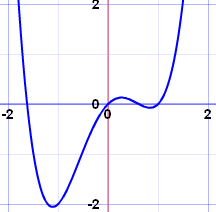If the function is continuous, it means that it is basically a graph with a single curve that isn't broken up into other smaller ones such as one that doesn't have asymptotes, a hole in the middle of the curve, etc. It's not quite the mathematical explanation but that's basically what they mean by it. An example of one would be this.


Original post by drinktheoceans
If the function is continuous, it means that it is basically a graph with a single curve that isn't broken up into other smaller ones such as one that doesn't have asymptotes, a hole in the middle of the curve, etc. It's not quite the mathematical explanation but that's basically what they mean by it. An example of one would be this.


so in this graph, the root will be lie in the interval [0,0.5]?
Original post by alesha98
what does "f(x) is continuous" mean in "sign change and f(x) continuous imply that the root lies in the interval"?
Being continuous means, intuitively that you can draw the curve without taking your pen off the paper.
Spoiler
Since you need to be able to draw the curve, if it goes from positive (above the x-axis) to negative (below the axis) then it MUST have passed through the x-axis on the way. See "We're going on a bear hunt" for the logic involved
 A root is simply a point where the curve is touching the axis (or crossing).
A root is simply a point where the curve is touching the axis (or crossing).Note that continuity is actually important - if you don't take it into account you'd think that 1/x has to have a root in the interval [-1,1] but we know that it doesn't. This is because it is discontinuous.
Original post by lerjj
Being continuous means, intuitively that you can draw the curve without taking your pen off the paper.
Since you need to be able to draw the curve, if it goes from positive (above the x-axis) to negative (below the axis) then it MUST have passed through the x-axis on the way. See "We're going on a bear hunt" for the logic involved A root is simply a point where the curve is touching the axis (or crossing).
A root is simply a point where the curve is touching the axis (or crossing).
Note that continuity is actually important - if you don't take it into account you'd think that 1/x has to have a root in the interval [-1,1] but we know that it doesn't. This is because it is discontinuous.
Spoiler
Since you need to be able to draw the curve, if it goes from positive (above the x-axis) to negative (below the axis) then it MUST have passed through the x-axis on the way. See "We're going on a bear hunt" for the logic involved
 A root is simply a point where the curve is touching the axis (or crossing).
A root is simply a point where the curve is touching the axis (or crossing).Note that continuity is actually important - if you don't take it into account you'd think that 1/x has to have a root in the interval [-1,1] but we know that it doesn't. This is because it is discontinuous.
ohhhh thankyou so much
Original post by alesha98
what does "f(x) is continuous" mean in "sign change and f(x) continuous imply that the root lies in the interval"?
Take a look at the "Intermediate Value Theorem".
Quick Reply
Related discussions
- Further Maths modules
- Best A level subject combinations for economics bsc degree
- What units do I need for Edexcel IAL or IAS Further Maths
- Edexcel Further Mathematics Mechanics Exam 14th June 2023 [Exam Chat]
- Further maths - FP1, FP2, FM1 second year, after FM1, FS1 1st year
- A-Level Further Maths Options
- Edexcel IAL Maths & Further Mathematics
- FM module?
- Further maths
- What A Level Further Maths Modules are best for Engineering?
- can someone explain how edexcel further maths works
- Results Plus Direct Exam missing
- How's FM1 - Edexcel?
- Messed up CIE Math P3 and Physics P4.
- As level further maths in 6 months
- gyg journal ⋆。‧˚ʚɞ˚‧。⋆
- Further Maths 2023/2024!!!
- Further Maths Modules
- Further Maths Summations Help
- Edexcel IAL Math and Further Math formulas
Latest
Trending
Last reply 3 days ago
Did Cambridge maths students find maths and further maths a level very easy?Last reply 2 weeks ago
Edexcel A Level Mathematics Paper 2 unofficial mark scheme correct me if wrongMaths
71
Trending
Last reply 3 days ago
Did Cambridge maths students find maths and further maths a level very easy?Last reply 2 weeks ago
Edexcel A Level Mathematics Paper 2 unofficial mark scheme correct me if wrongMaths
71




